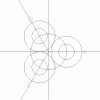williB
New Member
they are mounted on an 8 '' saw blade..JimB said:Willie,
What are the magnets mounted on? I cannot tell.
JimB
i realize it is hard to see from the pics, but they are mounted on steel.
the rotor, from the magnets outward , is composed of a sheet of paper with the magnet layout, necessary.! then the saw blade approx 1/8 '' thick, sorry Bryan not 3/8.. i am working on a shoe string here guys..then there is a plastic cover , which serves two purposes , it acts as a chain guide and prevents the chain from sticking to the magnets. :lol:
yes! the chain would stick to the other side of the rotor , right through the steel..
its correct..The rather odd ratio of magnets and coils, I would have expected a ratio of 1:1 or 2:1, but I am not an expert on 3 phase genrators.
For single phase you need two magnets passing over each coil at the same time..
But for three phase the coil to magnet ratio has to be a multiple of 3/4.
which means that ,at the very least ,you could have three coils and four magnets , both evenly spaced on their respective platforms..
You could also have 6/8 , 9/12 , 12/16 , 15/20, or 18/24
On your question of a magnetic circuit , any ferrus metal near the magnets ,causes cogging..
none of the axial wind generators on otherpopwer.com have any..but i did try it a while ago , i had strips of steel under the coils, there are probably pics of it in my earlier workings..
one more thing that i've found out , when working with cylinder magnets, the coil should be twice the width of the magnet , with the center of the coil equal to the magnet diameter..
if you are interrested i will post some pics of a 3 coil 4 magnet generator seperatly so you could print them out and you'll see that as thr rotor turns each phase is 120 degrees apart..








